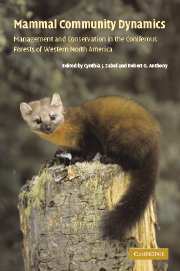 Mammal Community Dynamics
Mammal Community Dynamics Book contents
- Frontmatter
- Contents
- List of contributors
- Foreword
- Acknowledgments
- Part I Management and conservation issues for various taxa
- 1 Introduction and historical perspective
- 2 Forests and woodlands of western North America
- 3 Faunal composition and distribution of mammals in western coniferous forests
- 4 Habitat ecology and conservation of bats in western coniferous forests
- 5 Ecological relationships of terrestrial small mammals in western coniferous forests
- 6 Ecology and conservation of arboreal rodents of western coniferous forests
- 7 Small and mid-sized carnivores
- 8 Ecology, conservation, and restoration of large carnivores in western North America
- 9 Ungulates in western coniferous forests: habitat relationships, population dynamics, and ecosystem processes
- Part II Community and ecosystem relations
- Part III Conservation issues and strategies
- Index
- References
1 - Introduction and historical perspective
Published online by Cambridge University Press: 15 December 2009
- Frontmatter
- Contents
- List of contributors
- Foreword
- Acknowledgments
- Part I Management and conservation issues for various taxa
- 1 Introduction and historical perspective
- 2 Forests and woodlands of western North America
- 3 Faunal composition and distribution of mammals in western coniferous forests
- 4 Habitat ecology and conservation of bats in western coniferous forests
- 5 Ecological relationships of terrestrial small mammals in western coniferous forests
- 6 Ecology and conservation of arboreal rodents of western coniferous forests
- 7 Small and mid-sized carnivores
- 8 Ecology, conservation, and restoration of large carnivores in western North America
- 9 Ungulates in western coniferous forests: habitat relationships, population dynamics, and ecosystem processes
- Part II Community and ecosystem relations
- Part III Conservation issues and strategies
- Index
- References
Summary
Conservation and management of mammals in western coniferous forest has been one of the important topics in ecology over the last two decades. The level of attention that such species as the grizzly bear, lynx, gray wolf, elk, and bison have attracted, plus the time and funds that have been expended on behalf of their management, exemplifies this interest. Listings of various species as threatened or endangered under the Endangered Species Act (ESA), particularly grizzly bears and gray wolves, has stimulated much research, initiated management activities, and prompted many political and legal decisions concerning the management of mammalian species. During this time period, however, a paradigm shift has changed emphasis from single-species conservation to conservation strategies for communities and ecosystems. This paradigm shift and the many legal challenges to federal agency management and policy decisions have resulted in the development of several ecosystem-level management plans, including the Northwest Forest Plan, the Interior Columbia River Basin Ecosystem Management Project, the Tongass National Forest Management Plan, the Sierra Nevada Ecosystem Project, and the Southern California Forest-Urban Interface Plan (Johnson et al. 1999). As a result of these research and conservation activities, increased information on mammalian communities, as well as interest in their management, has become available.
The geographic focus of this book is from the east side of the Rocky Mountains to the Pacific Ocean and from the southern United States to northern Canada and Alaska.
- Type
- Chapter
- Information
- Mammal Community DynamicsManagement and Conservation in the Coniferous Forests of Western North America, pp. 3 - 8Publisher: Cambridge University PressPrint publication year: 2003


